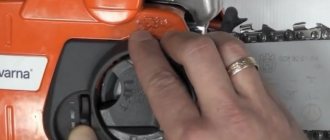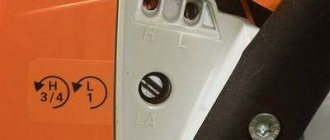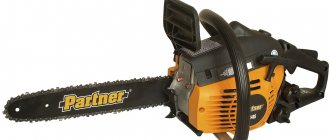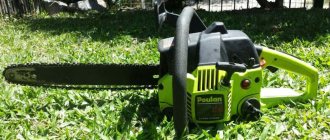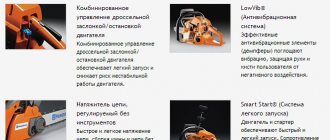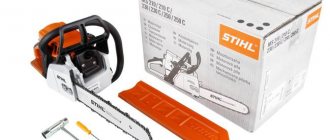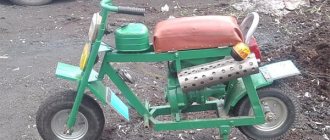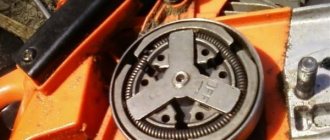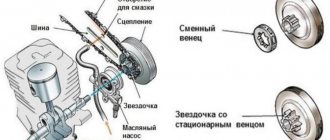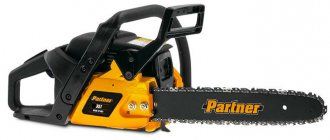Chainsaw Partner 350 – malfunctions and their elimination
Failures of Partner garden tools can occur for various reasons, the most common of which are improper operation and mechanical shock. To eliminate the malfunction, you will need to determine its exact cause in advance. After this, you can begin repairing the instrument yourself.
Chainsaw Partner 350 starts and stalls
There may be several reasons for this malfunction. Most often, the engine of the tool starts and immediately stalls due to a clogged factory breather, as a result of which fuel does not enter the engine cylinder in sufficient quantity for operation. To fix the damage, you will need to remove and clean the breather. If it is damaged, then it will need to be replaced.
Another reason is the missing connection between the spark plug and the electrical wiring cap. This can happen due to mechanical shock or the formation of carbon deposits from engine oil on the spark plug. To repair the Partner 350 chainsaw, the spark plug will need to be removed and cleaned. In some cases, completely replacing the spark plug may help.
The third reason for the malfunction is that the standard muffler of the chain saw is severely clogged. Over time, carbon deposits form on its walls, which prevents exhaust from leaving the engine. As a result, gases accumulate inside the engine and interfere with its proper operation. To fix the damage, you need to remove the muffler and clean it with compressed air. You will also need to disassemble the engine and bleed its cylinder.
Chainsaw Partner 350 will not start - how to fix the problem?
When this breakdown is detected, the first thing that needs to be inspected is the condition of the air filter. If a large amount of dust has accumulated on it, the filter will need to be washed using clean gasoline.
Another common cause of malfunction is problems with the ignition system. To repair the chain saw, you need to remove its left protective cover and set the correct clearance between the flywheel and the ignition coil.
In some cases, replacing the fuel mixture will help solve the problem. To do this, you will need to drain the used fuel and fill the tank with a new mixture of pure gasoline and motor oil.
What to do if the chain on the Partner 350 chainsaw is not lubricated?
If the chain for the Partner 350 chainsaw is no longer lubricated with oil, this can lead to overheating of the bar and rupture of the saw set. Ignoring this problem also risks increasing the load on the engine, which can lead to engine failure.
The first thing you need to inspect if there is no lubrication on the chain is the oil pump. Over time, the teeth on its drive wear out, which can also occur due to clogging of the pump. It is usually impossible to restore the element, so it is best to replace it.
Often, lubricant does not reach the chain of the Partner 350 chainsaw due to clogged oil pipes. In this case, the hoses will need to be replaced by treating the joints with the fittings with sealant.
Fills a candle on a Partner 350 chainsaw
This common problem is encountered by chainsaw owners who add too much motor oil to the fuel mixture. It does not have time to burn in the cylinder, so part of the lubricant settles on the spark plug and other important elements of the garden tool.
Problem: chainsaw stalls after starting
A common situation : the Partner chainsaw stalls at high speeds, although before that it starts and runs without problems at medium gas. Sometimes at medium it also works intermittently - but at full throttle it immediately stalls. This problem is faced by many users who save on quality fuel.
Low-quality gasoline easily contaminates parts with soot. In this case, checking the filters (air and fuel) will not hurt. Moreover, the muffler suffers from poor fuel and the carbon deposits it creates.
The combustion products of dirty fuel simply clog it, forming an impenetrable plug of soot. This plug greatly reduces engine power. In this case, gasoline is consumed in large quantities, but there is no result in power. Check and clean the muffler:
- Remove any remaining fuel from the tank.
- Remove the muffler and take it apart.
- Do not leave the outlet open; cover it with a napkin or lid.
- Clean all carbon deposits from the muffler using a cable and/or detergent. According to reviews, “Mr. Muscle” for pipes or similar household chemicals has proven itself well.
- A clean muffler needs to be dried. To speed up the process, you can do this with a hair dryer.
Diagnosis of problems
Before you begin repairing the device, it is necessary to conduct a high-quality diagnosis of the saw. To determine the cause of the breakdown, you need to familiarize yourself in detail with the design of the Partner 350 chainsaw. Failure of the saw can be caused by damage to any of its parts, but the most common reasons are the following:
Main components of chainsaws Partner
- ignition element failure;
- damage to the fuel system;
- failure of the support shaft.
Each of these defects is accompanied by certain “symptoms” that will help accurately diagnose the problem.
Candle testing
Checking the spark in the Partner 350 chainsaw is carried out by removing this element from the saw and then connecting it to a high voltage wire. Correct operation of the spark plug is always accompanied by the release of a spark, so this parameter will be easy to track.
Miscellaneous spark plug failures
Problems in this area can be caused by the following damage:
- malfunction of the spark plug itself;
- weakening of contact in the wired network;
- broken ignition button;
- lack of ventilated passages between parts in the ignition system.
Adjusting the mixture and spark plugs of the Partner 350 chainsaw
Fuel system testing
Fuel is the main source of energy for the operation of the saw, so problems in the area of fuel processing can cause breakdowns. Checking the fuel in the Partner 350 chainsaw is the first stage of diagnosis. If the tank is full enough, you should carefully inspect the spark plugs. If the spark plug is dry, fuel is not passing through it. After discovering this fact, you need to check all elements of the system, starting with the carburetor.
Adjusting the carburetor of the Partner 350 chainsaw
The cause of the malfunction is as follows:
- failure of the engine cylinder-piston group;
- overheating of the piston and cylinder;
- foreign particles entering the engine.
If after a test fuel supply the Partner 350 chainsaw turns on, then the problem lies in other elements of the saw.
Chainsaw carburetor Partner 350
Bearing check
The support shaft of the saw should be checked for stability through the crankshaft bearings. The piston rod and bearings must be firmly attached to the frame. If, when the piston moves, gaps are observed between individual parts of the mechanism, then these elements must be replaced.
Repairing the fuel system of a chainsaw
When the fuel supply is interrupted , it is not surprising that the chainsaw does not work. Moreover, in this case there is only one problem: no fuel enters the cylinder. And there may be several reasons for this problem, and you have to find that very reason.
First, try disconnecting the fuel hose and observing the fuel pressure. A weak, intermittent flow indicates a clogged filter. Take it out, rinse and dry it, and if possible, replace it with a new filter. Also clear the breather (valve) of any blockages.
Check the condition of the carburetor filter and, if necessary, rinse it thoroughly, dry it and reinstall it. We talked in detail about setting up the carburetor above, and these actions in this case will also not be superfluous.
If the reason is not in the breather or in the carburetor, then everything may turn out to be trivial. Make sure there is enough fuel in the tank.
There may also be problems with the cylinder-piston group (abbreviated CPG) of the Partner chainsaw. This failure can be considered serious because the cylinder and piston are the basis of the engine. Therefore, the CPG is an expensive component, the cost of which reaches half the cost of the entire tool.
on the coordinated operation of the cylinder and piston. During operation, especially if operating rules are not followed, the cylinder, piston and rings may wear out. In this case, only replacing parts will help.
CPG parts may be damaged mechanically. These defects can be diagnosed independently. Remove the muffler. You can see the CPG in the hole. Scratches and scuffs on the surface of the cylinder , located chaotically, occur when debris, fragments, or solid foreign particles enter.
If the cylinder is darkened , and this defect is observed over its entire surface, then, in all likelihood, you filled the chainsaw with low-quality fuel. Bad gasoline also affects oil scraper rings. A worn surface of the cylinder on the muffler side is a sign of critical overheating of the chainsaw during operation. Minor mechanical damage can be corrected by replacing bearings, rings, etc. But in case of deep scuffing, the CPG will have to be completely replaced by contacting a partner chainsaw repair shop.
We have prepared an entertaining article about caring for drimiopsis.
Find out more about ageratum care here.
Basic faults
The following types of faults are typical for the Partner chainsaw:
- engine malfunctions, such as problems with ignition, fuel supply, or exhaust and piston-cylinder systems;
- failure of carburetor components, such as the clutch assembly, chain brake or lubrication system.
The causes of failures can be different, but most often it is improper operation, insufficient amount of oil or poor-quality fuel mixture.
How to remove and disassemble
Correcting malfunctions of a chainsaw carburetor is possible only after this part has been removed. And to do this you need to disassemble the chainsaw itself. This work will have to be done in the following sequence:
- Remove all components in strict order. First the chain brake cover and saw set, then the top cover, saw handle and starter.
- After these parts are removed, you need to clean the saw using a compressor with an attachment.
- After this, you need to plug the inlet window, since there is a risk of dirt and foreign objects getting inside.
Cleaning
You can clean the carburetor in different ways, most often it is done with air. The sequence of work is as follows:
- Unscrew the top bolt of the part cover.
- Remove the valve gasket. After this, you need to blow the mesh with compressed air. In this case, you should not blow closely, but at a short distance.
- There is no need to remove other parts of the carburetor. You can use a special liquid to clean the surface.
- Now the carburetor needs to be assembled, attaching the parts in the reverse order.
Other renovations
For the Partner chainsaw to operate efficiently, other repairs may be required. It is not difficult to carry out repairs with your own hands.
The most common problem is the lack of:
- sparks in the spark plug (you need to either clean the gap on the spark plug, or replace the coil or flywheel with similar parts);
- fuel supply (the cause may be a clogged hose or fuel filter);
- air supply (air filter needs to be washed).
Starting mechanism repair
When inspecting a disassembled starter, it is necessary to inspect the following parts (assemblies) for damage:
Replacing the chainsaw starting cord
- Drive pulley. A pulley subjected to high axial and radial loads must not have cracks or damage on the back side. If there are any, it is necessary to replace it with a new part.
- Starter spring. The main load when starting a chainsaw is the spring. Made from high-quality carbon steel and subjected to special heat treatment, it loses its properties over time. If cracks or tears are detected, a new spring will need to be installed.
- Launch rope. Made from synthetic, durable materials, the starter cord will wear out over time. If it breaks, it is necessary to install a new rope on the pulley.
After the repair work has been completed, it is necessary to reassemble the starting mechanism in reverse order. The ratchet pulley is installed on top of the spring. Before finally fixing the chainsaw starter cover, you need to wrap the rope and make several test pulls.
Do-it-yourself adjustment of the Partner 340 chainsaw carburetor
Initially, the carburetor on the Partner 340 chainsaw was adjusted by the manufacturer to operate in maximum power and efficiency mode. Additional adjustment may be necessary if traction characteristics deteriorate, which is possible due to sudden changes in air temperature or when filling the tank with other fuel.
The carburetor adjustment algorithm itself is performed as follows:
- To access the quality (marked H) and quantity (L) screws, the chainsaw has special holes on the left side. For convenience, you need to remove the protective cover.
- Tighten both screws all the way, and then unscrew each 1/5 turn.
- We start the chainsaw and warm up the engine for 5-10 minutes.
- Adjusting idle speed. To do this, tighten the screw T counterclockwise until the engine starts to operate as stably as possible. At the same time, make sure that the chain does not rotate (if it rotates, smoothly tighten the screw until it stops). If the engine stalls at idle, screw T needs to be unscrewed a little again.
- We adjust the engine power and mixture quality. Smoothly pressing the gas, we wait for the engine speed to increase to the maximum. According to the manufacturer, the maximum speed occurs at 11.5 thousand rpm (use a portable electronic tachometer for an accurate determination). If the speed does not increase, you need to turn screw L counterclockwise 1/8 of a turn. The maximum speed should not be allowed to exceed the recommended speed, because this can lead to ignition problems. In this case, turn screw H counterclockwise, thereby reducing the maximum speed
If you don’t have a tachometer at hand, you can determine if the carburetor is adjusted correctly visually. When the engine smokes heavily during operation (the mixture is rich), screw L must be tightened a little. When the engine warms up and picks up speed, screw H must be unscrewed counterclockwise by approximately ¼ turn.
Sometimes it happens that adjustment does not help. The engine does not develop speed or stalls. The cause may be a clogged filter or air intake. It is enough to clean and re-adjust the carburetor if necessary.
When is a clutch replacement necessary?
Removing and replacing the chainsaw clutch is carried out if a malfunction of the mechanism is detected. Such malfunctions include:
- Spring damage.
Depending on the model of the tool, the spring can be of two types - coil (band or single) or steel plate. The spring is damaged by stretching, separation, or mechanical failure. To determine the cause of the malfunction of the entire mechanism, you will need to remove the protective casing and drum - Drum damage and wear.
Failure of this part is often associated with pieces breaking off. If such a malfunction occurs, the drum will need to be replaced. The inside of the drum also wears out, so the part also needs to be replaced. If the drum is blue, this indicates that it has been overheated and cannot be used for further use. - Development of the mechanism.
It is connected primarily with the stretching of the spring, which can be replaced. The threaded connection also wears out. If such a breakdown occurs, the entire coupling will need to be replaced. - Sprocket wear.
Depending on the type of sprocket (collapsible or non-dismountable), it is replaced along with the drum and, if necessary, a coupling
The service life of the clutch mechanism depends not only on the quality of the components, but also on the correct operation of the tool.
To extend the life of the chainsaw clutch, you need to pay attention to signs that reduce the resource. These signs include:
- Frequent snagging or biting of the chain in the wood. In such situations, the clutch takes on the entire load, thereby protecting the engine from jamming
- It is forbidden to increase the speed when the handbrake is on, which also leads to wear on the mechanism due to overheating
- Use of low-quality oil, incorrect choice of tire, chain, etc. All this also affects the clutch, increasing the load, and thereby reducing the service life
Determining a device malfunction is quite simple. To do this, you need to cut the workpiece. If during the sawing process the rotation speed of the chain decreases or it stops when the load increases, then it’s time to check the clutch. We will consider in detail how to remove and replace the clutch on a chainsaw in the next section.
This is interesting! You can check the suitability of the compression spring by connecting a tachometer to the tool. At idle, you need to turn up the number of 2500-2700 revolutions per minute on the tachometer. At this value, the chain on the chainsaw should not rotate. If a different picture is observed, then this indicates a decrease in the compressive properties of the spring. It is recommended to replace it. Based on this, it should be noted that the chainsaw clutch is in close relationship with the carburetor. If you cannot adjust the idle speed on the chainsaw by adjusting the carburetor, then you need to check the serviceability of the clutch.
Additional recommendations
After purchasing a Partner-350 chainsaw, you can adjust the carburetor while using it. Before starting this work, please note that the settings installed at the factory are optimal. Using the screws described above, you can adjust the operation of the engine in special cases when extraordinary external circumstances require it, for example, individual climatic conditions. When adjusting, use the screws marked with the letters H and L. To reduce the speed, they must be turned counterclockwise. To increase the speed, you need to turn the screws in the opposite direction.
The required sequence of screw use is of great importance. It looks like this: L – H – T. If difficulties arise during the adjustment process, it is advisable to promptly seek help from a professional, since incorrect adjustment can cause engine damage.
Disadvantages of the saw
On the Russian market you can find low-quality fakes of the Partner 350 chainsaw, which is not only additional evidence of its popularity, but also harms the brand as a whole. And other models of this brand are popular with summer residents and farmers.
If you are ready to consider the Partner 350 as your home tool for sawing thin trees, trimming branches and other not very voluminous work, then you should also know the disadvantages, most often mentioned by their owners:
1. The vibration damping system is not of very high quality, as a result of which the hands get tired quite quickly. But, considering that this is a household tool that requires 15–20 minutes of rest every 20–25 minutes of work, you can put up with this drawback.
2. Oil leakage from the chain lubrication system, which, however, affects most chainsaws equipped with it, including the more famous relative of Partner chainsaws - Husqvarna. (link)
3. Lack of visual control of the oil level, which is not very convenient in operation, and operating the saw without lubrication will lead to rapid stretching, overheating and wear of the chain.
Of course, you can use this saw to cut down a tree up to 30 - 35 centimeters thick, but its main purpose is to work on the site. Therefore, in conclusion, we offer you the most objective video review of this model:
Dear readers, if you have any questions, please ask them using the form below. We will be glad to communicate with you;)
- list of components and parts;
- information on how to correctly read symbols on equipment;
- safety precautions when working with a saw and compliance with sawmill technology;
- instructions for the assembly sequence of the tool;
- correct composition of fuel mixtures and requirements for chain lubrication;
- instructions for maintenance of individual components;
- table of problems and methods for eliminating them;
- technical characteristics of the Partner chainsaw.
Official documents developed to help equipment owners provide comprehensive information on the correct operation of the saw.
Chainsaw Partner 350: characteristics and features
The Partner 350 chain saw belongs to the class of household or amateur hand-held gasoline saws. Amateur - does not mean a “club of interests” for chain saw lovers, but denotes the power and capabilities of the unit. This saw is one of the best in its class and is optimal for short-term work in the garden, on a summer cottage, etc.
With its help, you will trim bushes, prepare brushwood for the barbecue and wood for repairs, and cut down a small tree. All this is possible due to the following technical parameters:
- Weight: 4.7 kg
- Two-stroke engine power - 1.8 hp. (1300 W)
- Engine capacity: 34 cc.
- Electronic ignition system.
- The capacity of the oil tank is 0.2 l, the fuel tank is 0.4 l.
- Chain pitch: 3/8 inch.
- The maximum chain length is 41 cm, the optimal length is 35 cm.
- Primer for starting a cold engine.
The advantages of the Partner 350 chainsaw are its compact size and convenient operation. It has a built-in safety system: the double inertia brake is activated automatically as soon as an emergency situation occurs. potentially dangerous for the saw operator.
The chain is also automatically lubricated. At the same time, fuel is consumed very economically, and the air filter lasts longer thanks to the CCS system. It’s even surprising that at such high engine speeds the saw operates relatively quietly. As a nice “bonus”, the cylinder walls are coated with a special protective compound, and an anti-vibration system is built into the handles.
As for the shortcomings of the Partner 350 chainsaw, reviews on the forums speak volumes about them. It turns out that this model was first released in 2012 and then re-released in 2015. According to the documents, the updated model is more advanced. But in practice, copies of the first series are more reliable and break less often. In addition, this saw is not equipped with a shock absorber - this can be felt during prolonged use. Partner chainsaws are produced by the Swedish concern Husqvarna, which is well known to users of equipment for gardening, dacha and forestry. Factories producing Partner equipment are located not only in China, but also in the USA, Italy, and Great Britain.
Despite this, the price of Partner chainsaws is relatively low. Spare parts are also available. In Western countries, this brand is very popular due to its win-win combination of price and quality. But even Swedish quality sometimes fails.
Features of disassembling the Partner saw
Like any equipment and procedures with it, disassembling the Partner saw involves some features that its owner should be aware of.
You can learn a lot from our videos, but you should focus on the following nuances:
- The crater cover is installed without a gasket, but instead it is worth applying red sealant with a thin ball. Be sure to degrease both surfaces first so that they have better contact;
- use a special puller to remove the flywheel, although many specialists have adapted to using a wrench and lightly tapping with a drift;
It is not at all difficult to disassemble the Partner saw, relying on high-quality videos and step-by-step recommendations from our service specialists. In general, this mechanism consists of similar elements as most user-level chainsaws. Therefore, its disassembly and reassembly will not be difficult for you. The Kosi Kosa petrol tool store is pleased to offer you high-quality tools, as well as informative articles on the operation and repair of mechanisms.
How to adjust
Setting up the carburetor of a chainsaw Partner with your own hands requires preparing the following tools:
- tachometer (electronic crankshaft speed counter);
- slotted screwdriver;
- a set of filters (their replacement is part of the adjustment process).
You can adjust the carburetor on a Partner 352 or other model chainsaw only if you first clean it of dirt. For this, it is best to use a compressor with an air nozzle. The adjustment itself is performed in several stages:
- To access the adjustment screws, you need to remove the cover. They are also accessible through special holes on the left side of the carburetor. It must be remembered that the left screw is a quality screw (marked H), and the right screw is a quantity screw (marked L).
- After this, you need to tighten the screws completely and then loosen them ⅕ of a turn.
- Then the chainsaw needs to be started, since the carburetor can only be adjusted when the engine is hot.
- After this, the quantity adjustment screw must be tightened clockwise to maximum engine speed. Once this result is achieved, the screw must be unscrewed counterclockwise by ¼ turn. After this, the chainsaw should run at idle. If the revolutions are too low or too high, then use the throttle valve.
- Now, using the quality screw, the maximum speed is set. This parameter is determined by the tachometer. The maximum possible value can be easily viewed in the instructions. For example, for a chain saw Partner 350 this value is 12500 rpm
If there is no tachometer, then you can determine the quality of the adjustment visually. If the tool smokes a lot during operation, then the quantity screw needs to be tightened a little. Another option is also possible. A chainsaw may work well at idle, but poorly at maximum speed. The situation can be corrected by tightening the quality screw, while keeping the gas fully clamped.
Source
How to prevent chainsaw damage
Repairing a chainsaw can be very expensive in some cases. This can be avoided if you pay enough attention to the prevention and control of the condition of the instrument and all its parts. Moreover, it is not difficult to fulfill this condition - just use the operating instructions and adhere to rational accuracy:
To keep it in working order, you just need to strictly follow the instructions and follow some general rules:
- Do not allow the engine to overheat, take breaks in operation so that it can rest and cool down.
- Do not load the chainsaw beyond the capabilities of its class. For example, if you are using a household grade Partner 350 saw, then it is simply not designed to work for more than 40 minutes a day.
- Check the chain brake daily (this is done at maximum acceleration).
- Follow the manufacturer's requirements regarding the quality and composition of the fuel mixture.
- Check the condition of the spark plug weekly and clean the electrodes if necessary.
- Before using the saw, make sure the chain is sharp and installed correctly. Pay attention to the wear of the cutting links and sharpen them in a timely manner. Watch for cracks and breaks in the rivets.
- A properly tensioned chain does not sag, but it can be moved by hand. Never do this with a hot chain! Sharpen and/or tighten it after replacement.
- When refueling the chainsaw, make sure that dirt and other foreign particles do not get into the tank along with the fuel. Fill oil and gasoline carefully, do not spill them.
Often, when contacting a service center, it turns out that the Partner chainsaw broke down due to improper starting of the tool. Therefore, there is only one universal solution when a saw breaks down: handle it correctly, and most problems can be avoided.
And if you are interested in the reasons for breakdowns of the Stihl chainsaw, the second popular brand together with Partner, then the next article is about exactly that.
And for those who like to know more, we suggest you watch the video about chainsaw repair Partner
For people involved in construction or logging, as well as those living in their own residential premises with an adjacent plot of land, it will be very useful to own a high-quality Swedish chainsaw “Partner 350”, which is an excellent substitute for other tools for cutting wood, for example, two-handed saws or hacksaws .
Like any other units, chainsaws also require careful care and periodic maintenance , otherwise they will quickly break down as a result of use. At the same time, contacting qualified specialists with a request to repair a chainsaw costs money, which you may not want to spend for some reason, because you understand that you can fix most of the malfunctions and breakdowns yourself. To do this, you need to understand the structure of the chainsaw and watch the video, where you will receive detailed instructions for repairing the Partner 350 chainsaw.
Carburetor design
After making a decision to adjust the Partner-350 chain saw, the first thing you should do is study the design features of its parts. The most important component of the system is the diffuser, which serves as a constriction device to increase the flow rate of the supplied oxygen. The diffuser is located directly next to the inlet through which fuel is supplied. The flow of incoming oxygen is regulated using a tube with a transverse damper included in the carburetor design. Fuel is supplied through a needle-shaped nozzle. The carburetor design also includes a float chamber, the purpose of which is to regulate the fuel supply at the entrance to the channel.
Replacing the piston group
If it is necessary to replace the cylinder and piston of the Partner 350 chainsaw, it must be disassembled according to the algorithm described above. The piston is secured at the top of the crankshaft connecting rod using a piston pin. A separator with roller bearings is installed between the pin and the connecting rod.
To replace the piston and cylinder, it is necessary to remove the piston from the cylinder and remove it from the crankshaft; to do this, remove the piston pin stopper from one side of the piston using pliers and a small screwdriver.
Then it is squeezed out from the opposite side using a small screwdriver. If the pin comes out tightly, you can slowly knock it out using a hammer and a drift, suitable in size, but smaller than the diameter of the piston pin mounting hole.
To check the correct installation, you need to take the crankshaft with the piston installed on it so that the shaft on which the flywheel is installed is in your left hand, with the arrow facing away from you.
After the new piston is mounted on the crankshaft, a ring is installed on it, after which the piston is inserted into the cylinder, while the parts should be lubricated with engine oil, which will prevent the ring from breaking and make the process easier. Next, the crankcase is installed.
Service center technicians use an algorithm for replacing the piston group, which allows the work to be done without completely disassembling the Partner 350 chainsaw. How such a replacement occurs can be seen in the video.
Breather clogged
The breather of the presented model becomes clogged when low-quality fuel is used. In such a situation, repairing the Partner 350 piston chainsaw should begin with inspecting the carburetor. In order to see it, you will have to remove the top cover of the device. Next, the ignition module is twisted
After this, it is important to immediately disconnect the crank. In this case, you will have to use the keys
The next step is to disconnect the drum.
Immediately behind it is the carburetor. There is no need to remove it for inspection. First of all, the throttle is checked. In some cases, this may be the problem. If the throttle is fine, you need to look at the tire. When it is damaged, its sides are slightly knocked down. Cracks may also be observed in the central part of the tire. If the part is deformed, it will have to be replaced. It is better to purchase spare parts for the Partner 350 chainsaw in specialized workshops. It is quite difficult to install a tire on a carburetor yourself. In such a situation, it is more advisable to contact a specialist.
What problems require replacing the clutch?
The clutch is removed and disassembled in the following cases:
- When a spring bursts, when the motor functions unstably;
- The spring was asleep;
- The drum has chipped and noise is heard;
- Natural wear and tear after prolonged use.
The engines that are equipped with almost all modern models of chainsaws are connected by a gearbox to the saw surface. The chain moves, but if the idle speed is turned on, it remains motionless. When the load increases much beyond the permissible limit, the clutch stops supplying torque to the tire. This will cause the engine to stop. If such situations occur frequently, the clutch wears out much faster. Some manufacturers specifically indicate in their tool instructions that the clutch is not the main part that requires replacement after a while.
Chainsaw Partner P340S – tool design
The standard equipment of this amateur model includes everything necessary for continuous comfortable work on the site. The engine of the gas-powered tool is 1-cylinder, running on a fuel mixture of 92 gasoline and oil for lubricating 2-stroke engines. A proprietary Japanese Walbro carburetor, the walls of which are covered with a continuous layer of protective chrome alloy, is responsible for the continuous enrichment of fuel with oxygen and its supply to the cylinder.
To ignite the fuel in the engine cylinder, the ignition system, which consists of a coil and a spark plug located above the engine, is responsible. The principle of starting the engine is manual. For this purpose, the Partner chainsaw is equipped with a starter and a pump for pumping fuel into the cylinder before starting a cold internal combustion engine. A separate cover, which is secured with several screws, is responsible for protecting the spring and starter coil on the left side of the chainsaw.
For continuous connection between the motor and the saw set, the Partner chainsaw is equipped with a reinforced clutch, all parts of which are made of hardened steel. This material allows the mechanism to operate under higher loads without the risk of blue clutch cams.
To protect all the internal components of the chainsaw, the manufacturer equipped it with a durable casing made of several layers of sheet plastic. At the back of the case there are switches and a power button for the model. The chain inertia brake lever is located in the middle, and the handle and starter cable are on the left side of the housing.
How to increase the working life of the coupling?
At low speeds, elements with friction linings (1), having a degree of freedom in the circular direction, are attracted to the center of the shaft by springs (2) and do not transmit rotation to the drum (3), connected to the sprocket driving the chain. When the chainsaw engine speed reaches values at which the centrifugal force exceeds the force of the springs, the friction segments are pressed against the inner surface of the drum and begin to rotate it. As a result, the drive sprocket begins to rotate, driving the saw chain.
As you can see in the photo, the sprocket is located behind the clutch.
On other chainsaws, the sprocket may be located on the outside of the clutch.
To avoid unplanned repairs, the gas saw operator needs to adhere to certain recommendations. They will help extend the life of the chainsaw clutch and protect it from damage to the main operating elements.
These recommendations include:
- regular lubrication of coupling parts;
- timely cleaning of the mechanism from dust and dried oil;
- operate the chainsaw only with a fully serviceable bar and a high-quality sharpened chain;
- avoiding contact of the installed cutting set with hard metal objects.
Modern chainsaws are equipped with centrifugal clutches. This means that their work depends entirely on the torque of the motor, which the saw produces at a particular moment in time.
Its main structural elements are:
- drum;
- star;
- springs.
The principle of operation is as follows. When starting the saw, the elements that move freely in the radial direction are pulled together by springs towards the shaft axis. In this case, the torque does not flow to the drum, and therefore to the sprocket and guide. At the moment when the centrifugal force prevails over the force potential of the springs, the clutch elements weaken and compress at the inside of the drum, initiating its torsion. Together with it, the rotational cycle passes to the sprocket and the tire-chain set itself.
The main advantage of this type of clutch is that it slips when the cutting part suddenly brakes, which does not stop the engine. As a result, the “heart” of the saws - the motors - remain safe and sound.
Most modern chainsaws come equipped with a centrifugal clutch. The operation of these mechanisms directly depends on the torque generated by the engine.
In this case, the rotational force from the motor is not transmitted to the drum, drive sprocket and tire. Gradually, the pressure of the centrifugal force increases and displaces the force created by the springs. At this point, the clutch components lose their strength and begin to compress near the inside of the drum. Under the action of the springs, the drum begins to unwind. As it moves, it transmits rotation to the drive sprocket and the saw head of the chainsaw.
The main advantage of the centrifugal clutch is its instantaneous slipping at the moment when the cutting elements begin to rotate more slowly. At the same time, the chainsaw engine itself does not lose its original speed and continues to move as smoothly as before. This allows you to reduce fuel consumption and reduce the risk of burrs in the CPG of the utility saw motor.
How does a carburetor work?
Correct adjustment is only possible if the structure of the chainsaw carburetor has been studied in advance and the quality of this part has been checked. For example, for the Partner p350s tool, the carburetor manufacturer is Walbro. The indicator of quality in this case is the WT-891 marking.
The carburetor of the Partner 371 chainsaw or any other model has a classic structure. The main elements are:
- fuel pump;
- main chamber with membrane;
- throttle and air dampers;
- screws (adjusting quality, quantity and idle speed adjustment).
In addition to these parts, the carburetor has technological channels through which the mixture of gasoline and oil moves.
The principle of operation is as follows. An impulse is supplied from the crankcase to the fuel pump. This is where the work of the carburetor begins. After receiving the impulse, the fuel mixture is directed to the main chamber, entering there through a needle valve, which is controlled by a diaphragm. From the main chamber, the liquid is directed through the technological channels into the cylinder, and the amount of liquid can be independently adjusted using the throttle valve.
Additionally, the throughput of technological channels can be adjusted. For this purpose, it is necessary to use quality and quantity screws, which work on the principle of valves.
Replacing the piston group
If it is necessary to replace the cylinder and piston of the Partner 350 chainsaw, it must be disassembled according to the algorithm described above.
The piston is secured at the top of the crankshaft connecting rod using a piston pin. A separator with roller bearings is installed between the pin and the connecting rod. To replace the piston and cylinder, it is necessary to remove the piston from the cylinder and remove it from the crankshaft; to do this, remove the piston pin stopper from one side of the piston using pliers and a small screwdriver.
Then it is squeezed out from the opposite side using a small screwdriver. If the pin comes out tightly, you can slowly knock it out using a hammer and a drift, suitable in size, but smaller than the diameter of the piston pin mounting hole.
To check the correct installation, you need to take the crankshaft with the piston installed on it so that the shaft on which the flywheel is installed is in your left hand, with the arrow facing away from you.
After the new piston is mounted on the crankshaft, a ring is installed on it, after which the piston is inserted into the cylinder, while the parts should be lubricated with engine oil, which will prevent the ring from breaking and make the process easier. Next, the crankcase is installed.
Service center technicians use an algorithm for replacing the piston group, which allows the work to be done without completely disassembling the Partner 350 chainsaw. How such a replacement occurs can be seen in the video.
What problems require replacing the clutch?
The clutch is removed and disassembled in the following cases:
- When a spring bursts, when the motor functions unstably;
- The spring was asleep;
- The drum has chipped and noise is heard;
- Natural wear and tear after prolonged use.
The engines that are equipped with almost all modern models of chainsaws are connected by a gearbox to the saw surface. The chain moves, but if the idle speed is turned on, it remains motionless. When the load increases much beyond the permissible limit, the clutch stops supplying torque to the tire. This will cause the engine to stop. If such situations occur frequently, the clutch wears out much faster. Some manufacturers specifically indicate in their tool instructions that the clutch is not the main part that requires replacement after a while.

